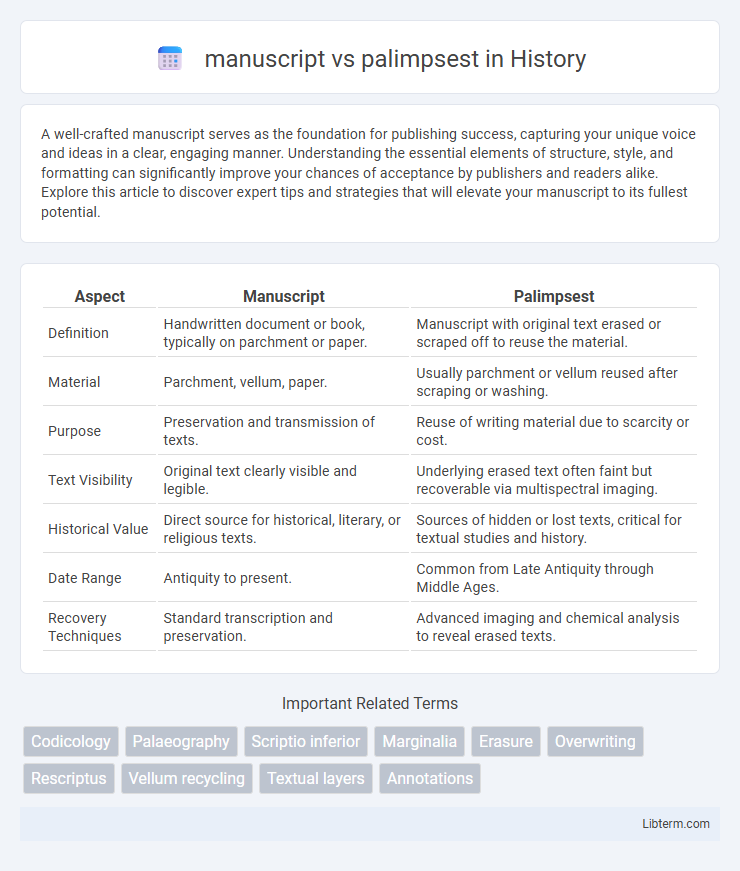A well-crafted manuscript serves as the foundation for publishing success, capturing your unique voice and ideas in a clear, engaging manner. Understanding the essential elements of structure, style, and formatting can significantly improve your chances of acceptance by publishers and readers alike. Explore this article to discover expert tips and strategies that will elevate your manuscript to its fullest potential.
Table of Comparison
| Aspect | Manuscript | Palimpsest |
|---|---|---|
| Definition | Handwritten document or book, typically on parchment or paper. | Manuscript with original text erased or scraped off to reuse the material. |
| Material | Parchment, vellum, paper. | Usually parchment or vellum reused after scraping or washing. |
| Purpose | Preservation and transmission of texts. | Reuse of writing material due to scarcity or cost. |
| Text Visibility | Original text clearly visible and legible. | Underlying erased text often faint but recoverable via multispectral imaging. |
| Historical Value | Direct source for historical, literary, or religious texts. | Sources of hidden or lost texts, critical for textual studies and history. |
| Date Range | Antiquity to present. | Common from Late Antiquity through Middle Ages. |
| Recovery Techniques | Standard transcription and preservation. | Advanced imaging and chemical analysis to reveal erased texts. |
Understanding Manuscripts: Definition and Origins
A manuscript is a handwritten document created before the invention of the printing press, typically produced on parchment or vellum and dating back to ancient or medieval times. Palimpsests are manuscripts that have been scraped or washed to remove the original writing, allowing the material to be reused for new text, often revealing multiple layers of historical information. Understanding manuscripts involves recognizing their role as primary sources of historical, literary, and cultural knowledge, while palimpsests provide unique insights due to their overwritten content and preservation challenges.
What is a Palimpsest? Key Characteristics
A palimpsest is a manuscript page from which the original text has been scraped or washed off to reuse the material for another document, often due to the scarcity of writing surfaces like parchment. Key characteristics include visible traces or faint remnants of the original writing beneath the newer script, layered text that can be revealed through multispectral imaging, and historical reuse reflecting economic and material constraints of the medieval period. Palimpsests provide valuable insights into earlier texts, making them crucial for the study of paleography and textual transmission.
Historical Context: Manuscripts Through the Ages
Manuscripts have been essential in preserving knowledge from ancient civilizations, serving as primary records in cultures such as Mesopotamia, Egypt, and medieval Europe, reflecting the transmission of religious, scientific, and literary texts. Palimpsests, created by scraping or washing away earlier texts to reuse costly writing materials like parchment, reveal historical layers and lost works, offering unique insights into cultural and textual evolution. The study of both manuscripts and palimpsests enriches our understanding of historical literacy, material culture, and the adaptive practices of scribes across centuries.
The Creation Process: Manuscripts vs Palimpsests
Manuscripts are original documents created through the process of hand-copying texts, preserving the initial content with intentional clarity and detail. Palimpsests, on the other hand, involve the erasure or scraping of earlier writing to reuse the same material, resulting in layers of text that reveal historical revisions and modifications. The creation process of palimpsests highlights resourcefulness and material scarcity, contrasting with the manuscript production's focus on the accurate transmission of information.
Reasons for Creating Palimpsests
Palimpsests were created primarily due to the scarcity and high cost of writing materials like parchment in medieval times, prompting scribes to erase earlier texts for reuse. The practice allowed valuable or worn-out manuscripts to be repurposed while preserving essential content underneath the new writing. This process reflects economic and material constraints on manuscript production in historical contexts.
Materials and Techniques Used
Manuscripts are typically written on parchment, vellum, or paper using ink made from soot, gall nuts, or iron salts, with quills or reeds as writing instruments. Palimpsests involve a reused parchment or vellum surface where original text is scraped or washed off to create space for new writing, employing techniques such as scraping with a knife or washing with milk or oat bran. The distinct layering in palimpsests often requires multispectral imaging to recover underlying texts, showcasing the interplay of materials and preservation methods in historical document production.
Deciphering Palimpsests: Modern Technology
Modern technology revolutionizes the deciphering of palimpsests by employing multispectral imaging and digital enhancement techniques, which reveal hidden texts beneath overwritten surfaces. These advanced methods allow scholars to reconstruct original manuscripts that were erased and reused, preserving invaluable historical and literary information. The integration of artificial intelligence further accelerates text recognition and restoration, offering unprecedented access to ancient knowledge obscured in palimpsests.
Significance in Historical Research
Manuscripts provide direct insight into historical texts, preserving original writings that reveal authentic linguistic, cultural, and intellectual contexts from their time. Palimpsests, created by erasing and overwriting older texts, hold layered information crucial for reconstructing lost works and understanding the evolution of literary traditions. The study of palimpsests often uncovers previously unknown historical data, enhancing knowledge of ancient civilizations and textual transmission processes.
Famous Manuscripts and Palimpsests in History
The Dead Sea Scrolls exemplify famous manuscripts, offering invaluable insights into ancient religious texts. The Archimedes Palimpsest reveals overwritten Greek scientific treatises, illustrating historical reuse of parchment and the recovery of lost knowledge. Another notable palimpsest is the Codex Ephraemi Rescriptus, containing erased biblical texts beneath later writings, showcasing the layered preservation of historical documents.
Manuscript vs Palimpsest: Key Differences and Similarities
Manuscripts are original handwritten documents, often preserved in their entirety, whereas palimpsests are manuscripts that have been partially erased and overwritten with new text, revealing layers of writing. Both serve as valuable historical sources, but palimpsests provide unique insights through the recovery of underlying texts using modern imaging technology. The key difference lies in the manuscript's intact content versus the palimpsest's reused and multigenerational textual evidence.
manuscript Infographic

 libterm.com
libterm.com